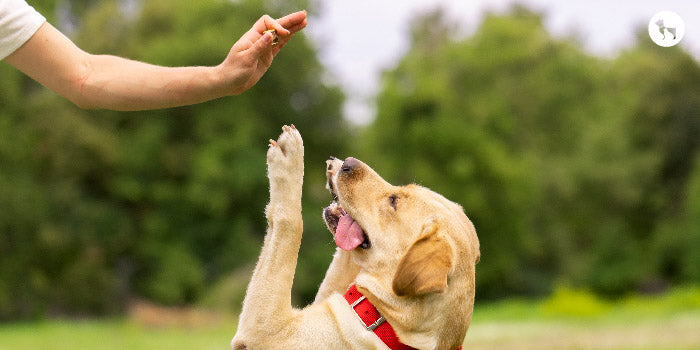

When I was 7 years old, I met my first pet dog - my cousin’s dog called Rani. When she’d bark, I’d bark back, thinking “barking” was a dog’s language. So a ‘Come’ would be ‘Woof’ and ‘Come let’s play!’ would be ‘Woof, woof woof!’. It amused my family because they knew Rani couldn’t understand my barks in reality!
You can say, I was barking up the wrong tree.
My cousin eventually taught me a few commands Rani was fluent in. Sit. Stay. Play. A few more words in Marathi too which I can't seem to recall. Rani, if she was alive, would never forget. Few questions stuck with my 7-year-old self - Can dogs really understand what we’re saying? Is it memory or is it comprehension?
If we take a recent example, @talkingdogmila went viral on the internet for playing with talking dog buttons. According to her Instagram bio, Mila can ‘understand’ a total of 36 human words in the English language and uses them to communicate with her pet parents daily. This brings up more questions.
Does Mila actually understand English? How does she know which button corresponds to which word? How does she interpret, understand and respond? Is this a feat of her cognitive abilities or do dogs have a magical secret language we aren’t aware of?
Today, we’ll be decoding a dog’s mind and learning more about these wonderful creatures. Let’s dig deeper!
|
Table Of Contents: - 2. Comprehending the language of dog 3. Comprehending human language 4. Comprehending human voice tone and context |
Thousands of years. That’s how long our dogs have lived and evolved with us humans. From an evolutionary standpoint, time has equipped our dogs with a unique ability to understand and communicate with us. This intimate relationship has helped shape their cognitive abilities and social behaviour, allowing them to adapt to our way of life and become our most cherished members of the family. Our two species have come together to create a new definition of love - growing together.
Some researchers believe that dogs have a rudimentary understanding of human language, similar to a human child’s comprehension (a 2-year-old). They might not grasp the meaning of every sentence we say, but they can infer intent and respond to basic cues and commands. What does this suggest? While dogs might not understand human language in the way we do, they are capable of learning and responding to us in meaningful ways. Does this mean our dogs do not understand us for who we are? I think not.

The more time I spend with dogs, the more I feel that our dogs are creatures of actions, habits and emotions rather than words. How true is this? To understand whether dogs understand any human language, we must first examine their own communication systems.
A dog will typically engage with another dog through the use of body language, facial expressions, vocalisations and scent cues. These signals are omnipresent for all dogs, across borders, meaning that dogs utilise various forms of communication signals rather than a spoken language like us humans.
What about when we speak to our dogs? Do they understand us? According to research done by intrigued scientists and researchers, dogs are more likely to pick up on a few words or phrases, but in most cases, they are more likely to respond to our body language, our facial expressions, the tone of our voice and the context of the situation.
Over time, a dog will form emotional associations with certain behaviours. So for example, for Rani, to sit was a positive experience because it was followed by her getting her favourite treat. Or when we’d pick up her leash and ask her for a walk, she would associate that word with freshly mowed green grass and endless scents to explore. Similarly, for Mila, pressing a ‘Potty’ button on the game would mean her parents would take her outdoors for some private ‘me’ time where she might run into another friend. We can only assume what our dogs associate it to but we know the associations are happy ones.
Watch Here:
https://www.instagram.com/reel/Cn4tsmspR8Q/?utm_source=ig_web_copy_link&igsh=MzRlODBiNWFlZA==
Credits

Expertise on this subject is divided. The first half says while dogs can learn human words, they might not know exactly what they mean. The second half argues that dogs are complex beings and until we have more data, we cannot single out the possibility of dogs recognising parts of our “post-office-daily-rants”.
No matter the stance, what we can’t refute is that our dogs are capable of not only recognising but learning a surprisingly long list of words. There are many therapy and sniffer dogs who are trained to understand hundreds of words and follow complex commands. However, their understanding may be based more on associative learning than true comprehension of the languages.
One famous example is Chaser, a border collie who gained fame for her understanding of over 1,000 words! Chaser’s parent, Dr. John Pilley spent YEARS teaching her the names of various toys and when asked, she was able to retrieve them. While Chaser’s victory is incredible and feels exciting to us as pet lovers, it is also an insight that her understanding of the word doesn’t necessarily translate to her understanding the abstract meaning behind the said word. Instead, it’s more likely that she associates the sounds with specific objects or actions. How smart!
But memory isn’t our dog’s only strong suit. There’s more to the eye when it comes to our furry family members.
The sofa has been ripped apart. You ask them, “Who did this?”. In response you get puppy eyes trying to convince you for forgiveness. There’s no debate that our dogs do comprehend our voice and tone, given the context. Dogs are empaths with high sensitivity to the emotional content of our speech.
Subtle changes in tone, pitch and intonation are a clear indication for them to gauge our mood and respond accordingly. Happy, cheerful and upbeat tones are to be perceived as positive and in turn they’d let those tails wag in excitement! On the flip side, if you use a stern tone, their reactions would be to adjust their behaviour to the circumstance. An angry tone? Might make them either extremely scared or even aggressive to protect themselves.
https://www.instagram.com/reel/C3icDvKxaOE/?igsh=MWN3aHRoeHFqbHRlZw==
Our bundles of joy have a beautiful ability to interpret human emotions and this in itself is a testament to the undying bond between us. It also makes us reflect on how big of an impact our behaviour and body language is on their little world. We truly are their everything.

Clear communication, consistent cues and positive reinforcement are the holy trinity of effectively communicating with our dogs. Training, playing or spending time with our dogs help them understand and respond to us and forge deeper bonds. This is exactly how Mila was able to learn her 36 human words. Each dog is different and so is their pace of learning and development. Start slow and talk to them as if you would talk to a 2-year-old.
Learn more about dog training here.
While these games are blowing up on the internet, how do they work? The more I read up, the more fascinated I was. These games were inspired by the Fitzgerald Key, a tool developed by Edith Mansford Fitzgerald to aid hearing-impaired students form grammatically correct sentences.
In the case of @talkingdogmila, if you scroll enough, you’ll observe that not only does she communicate about her own desires and feelings, but is also able to understand and communicate on behalf of the other dogs in the home. Dogs are extremely sensitive and social creatures and have the special ability to pick emotional and social cues we might miss. So it’s not wrong to say that we’ve been looking at animal communication extremely differently.
Fortunately, the research is in full swing and we’ll be witnessing animal communication in a new light and learning more about how these species communicate with us in remarkable ways.
While dogs are highly attuned to both specific words and our tones of voice, they’re more attached to the latter. While they might respond to certain words associated with familiar actions or treats, they also interpret the emotional content conveyed through the tonality. Positive reinforcement, consistent cues and a cheerful tone are the trinity of a happy conversation with your dog.
A dog’s understanding of humans relies heavily on your body language. They rely on visual cues such as hand signals, facial expressions, and body postures to interpret and understand verbal commands. Consistent use of gestures and verbal cues enhances a dog’s comprehension and responsiveness.
In a way, yes. While dogs may not completely understand our languages in the same way as we do, they can learn to associate specific words with actions or outcomes through consistent reinforcement. Dogs are also skilled at recognising patterns and context, allowing them to respond to familiar words or phrases.
Body language, facial expressions, vocalisations, and scent cues are a dog’s way of conveying messages and interacting with humans and other animals. Understanding these non-verbal cues is essential for effective communication with dogs.
Dogs are highly sensitive to a human’s emotions. They can discern our moods or intent behind spoken words and are quick to respond to changes in tone, pitch and intonation and adjust their behaviour accordingly. Happy or soothing tones may show positive responses, while harsh or angry tones may cause fear or agitation in our dogs.